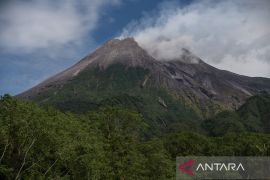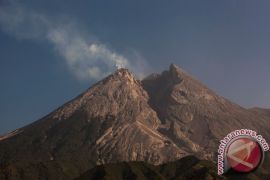The sliding distance of the ash clouds ranged from 500 to three thousand meters in the southwest direction, or upstream of Krasak and Boyong Rivers.
"These hot clouds were recorded on a seismogram with an amplitude between 15 and 60 mm and a duration of 83 to 197 seconds," head of the Center for Geological Disaster Research and Technology Development (BPPTKG), Hanik Humaida, said here on Wednesday.
Based on BPPTKG observation data recorded from 12 a.m. to 2 p.m. Western Indonesian Standard Time (WIB) on Wednesday, the farthest sliding distance of hot clouds of three thousand meters was observed at 12:53 p.m. WIB, with an amplitude of 55 mm and a duration of 317.8 seconds.
The gliding distance of the hot clouds was still within the danger radius set by the BPPTKG, which is five kilometers from the summit of Mount Merapi in the direction of Boyong, Bedok, Krasak, Bebeng and Putih rivers.
Related news: Ash rain blankets Boyolali after Mount Merapi belches hot clouds
Related news: Locals flee as Mt Merapi spouts massive ash column again
Following the eruption, volcanic ash blanketed a number of villages in Tamansari sub-district, Boyolali district, and Boyolali city.
The authorities have urged local villagers to wear face masks, eyeglasses, and cover water sources during volcanic ash rain.
"In addition to the ash rain that still occurs in the peak area, people also need to be aware of the dangers of lava, especially when it rains at the top of Mount Merapi," he said.
Since January 4, 2021, Mount Merapi has entered an effusive eruption phase, also known as the Merapi type, which is categorized by eruptions with activity in the form of lava dome growth, accompanied by falling lava and hot cloud avalanche, according to officials.
The BPPTKG has maintained the status of Mount Merapi at Level III, or alert, with the current potential hazards in the south-southwest sector, including the Boyong, Bedog, Krasak, Bebeng, and Putih Rivers for a maximum of five kilometers.
"Meanwhile, explosive eruptions still have the potential to occur with the eruption of volcanic materials, which could reach a radius of some three kilometers from the summit,” BPPTKG head Humaida said.
The 2,968-meter (9,737-foot) Mount Merapi is the most active of Indonesia's 130 active volcanoes.
Related news: 550 residents seek refuge to safeguard from Mt Semeru's eruption
Related news: Mt. Merapi showing heightened activity: monitoring agency
Translator: Luqman Hakim, Fardah
Editor: Rahmad Nasution
Copyright © ANTARA 2021






